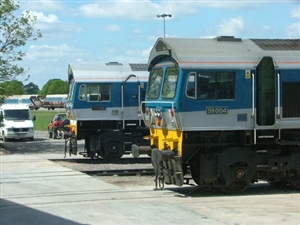Foster Yeoman decided to purchase a small fleet of locomotives and create an in-house rail freight operation to meet their own needs and aspirations. The specification was for a locomotive capable of pulling trains of over 4000 tonnes on the applicable grades and curvatures without double-heading and with a proven availability of 95% evidenced by operation anywhere on the globe. No British-made locomotive could meet these requirements. The answer lay with a scaled-down version of an existing EMD locomotive, adapted from the US to the British loading gauge. The book describes what happened next. Around ten years later, a derivative of the Class 59 was bought in much larger numbers by other freight operators and can be seen all over the UK rail network.
I was fortunate to visit Merehead with the IEE in 2004 and one of the highlights of the visit was the chance to get close to some Class 59s (albeit through the coach window!).
The book highlights a key technological development that enabled the Class 59 to pull heavier trains than any other single locomotive in the UK at the time. This was an EMD innovation, credited in the book to Bruce Meyer, known as "Super Series" creep control. It uses a sophisticated algorithm acting on wheel speed and ground speed (measured with doppler radar) to adjust the degree of wheel slip to maximise tractive effort. As the book says:
The nub of creep control is that a locomotive accelerating from rest can develop from 33 to 50% more tractive force if its powered wheels are allowed to creep into a slight, steady slip.
Sand has been a common means of increasing low-speed tractive effort since the days of steam, but it brings significant operational problems. Super Series provides automatic, single-input control of a very complex function, governing the field current of six traction motors, and reduces sand application by up to 70% on top of that. Brilliant!
The influence of sand on traction is clear reference to the Stribeck curve. But what about Super Series? How can increasing the sliding speed increase the coefficient of friction?
Super Series was invented before the internet became popularised and I am not aware of an engineering-based explanation in the public domain. There is not even a suitable entry on Wikipedia! It would be really interesting to see other people's theories and ideas on this point.
Nearly thirty years after the Class 59s' introduction into the UK, optimisation of the rail/wheel interface remains a challenge for railway traction engineers. While Super Series is ideal for heavy-haul freight trains, the rail industry demands new and different solutions. A recent seminar in London addressed the topic; no doubt the discussion was very informative. Surely nature is as fertile in presenting diverse problems as tribologists are in solving them!
